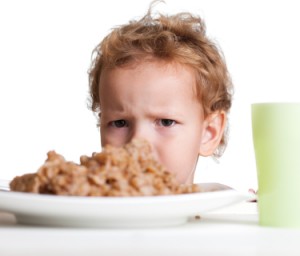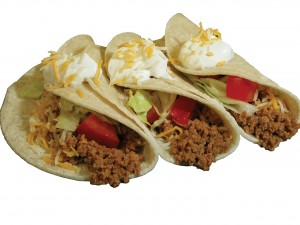
We all know that we have to cut down on fat and not eat quite so much red meat. But how can you convince your family to give up their favorite dishes like pizza, lasagna, and tacos? The good news is that you don't have to! My husband was a certified meat-lover who would turn up his nose at salads and meatless dishes. I thought it would be impossible to change his eating habits. Then we discovered textured vegetable protein.
Made from soybeans, textured vegetable protein is a meat substitute that is used in a variety of foods. When cooked, it resembles ground beef or chicken. Sound too weird to try? Actually, you probably have already eaten textured vegetable protein! Most "bacon bits" that you use on salads and potatoes are made of textured vegetable protein. And textured vegetable protein is in most convenience foods and fast foods as a meat extender. Just check the label. If it says "texturized soy flour" then you know the food contains textured vegetable protein.
Unlike a lot of vegetarian meals, textured vegetable protein resembles real meat, in flavor as well as texture. It's a by-product of soybean oil, so it's a natural food. And not only is textured vegetable protein a great meat substitute, there's some great side benefits to cooking with textured vegetable protein.
Textured vegetable protein is more economical than meat. Even the cheapest cuts of meat are far more expensive than your average serving of textured vegetable protein. Depending on what area you live in, you could save as much as 86% over the cost of real hamburger. And remember, hamburger is not 100% beef. Up to 20% of beef fat is added to ground hamburger, depending on the grade of meat you buy. This means, after you’ve browned the meat, drained it, and rinsed the extra fat away, you end up with a lot less hamburger. With textured vegetable protein, none of that food value is lost in preparation.
Textured vegetable protein is easy to prepare—even easier than real meat! I never liked the hassle of preparing ground beef. It's a lot of effort to defrost your hamburger, fry and drain the meat. And you have to deal with greasy pans afterward. With textured vegetable protein, it's so much simpler. Just simmer in water for ten minutes, and your textured vegetable protein is fully rehydrated. Keep in mind that textured vegetable protein should be handled just as you would raw meat. Make sure your cooking area is clean and you refrigerate rehydrated textured vegetable protein if you're not currently cooking with it.

*tacos using textured vegetable protein. Looks the same as cooking with real meat!
Recipes
You don't even need to re-hydrate textured vegetable protein to cook with it! Just add it to whatever you're cooking and simmer for an extra ten minutes. You will have to add extra liquid to your recipe (see back of #10 can for details). For me, there's nothing easier than tossing a handful of beef textured vegetable protein while my spaghetti sauce simmers, then I can attend to other things.
Plus, you don't have to learn new recipes to try textured vegetable protein! Many of the recipes that I've included here are adaptations of family favorites. If you have a recipe that calls for ground beef, diced chicken, or crumbled bacon, you can use that flavor of textured vegetable protein. Just make sure to add extra liquid when you add it dry to a recipe. And if you are making a dish with a mild flavor, you might want to add a dash of Worcestershire sauce.
Textured vegetable protein is lower in fat than red meat. A lot lower, in fact. The average serving of textured vegetable protein contains usually about 5 grams of fat. That's the same as lean broiled chicken or fish. And the fat found in the soy of textured vegetable protein is vegetable fat, which is much healthier than animal fat.
Still not convinced about textured vegetable protein? Try a little experiment with your family. The next time you cook hamburger, substitute beef textured vegetable protein for half of it. I'd be surprised if they notice the difference. Once I served lasagna made with textured vegetable protein (recipe included below) to several unsuspecting friends. They raved and finished off the whole lasagna!
To get you started, I've included some recipes that my family asks for again and again.
"Guiltless" Lasagna
To make this lasagna really low-fat, use fat-free cottage cheese and low-fat or fat-free mozzarella cheese.
1 cup Emergency Essentials beef textured vegetable protein
10 oz. large lasagna noodles
1 minced garlic clove
1 Tbl. basil
1 1/2 tsp. salt
2 6-oz. cans tomato paste
1/2 cup onion, minced
Cheese Filling:
3 cups cottage cheese
1/2 cup grated Parmesan
1 lb. mozzarella cheese, grated
2 Tbl parsley flakes
1 tsp oregano
2 beaten eggs
2 tsp. salt
1/2 tsp pepper
Preheat oven to 375º F. In a large saucepan, add all ingredients except lasagna noodles and cheese filling ingredients. Fill tomato paste can with water 4 times and add to sauce. Simmer for 30 minutes, stirring occasionally. While "meat" sauce is cooking, cook lasagna noodles until tender. Mix cheese filling ingredients well, reserving 1/2 cup of mozzarella cheese for the top. Spray pan with non-stick spray. Pour 1/3 of meat sauce on the bottom of the large pan. Next, lay a layer of 1/2 noodles, and 1/2 cheese filling. Repeat, ending up with meat sauce on the top. Use reserved 1/2 cup of mozzarella to top lasagna. Bake for 30 minutes. Let stand 10 minutes before cutting. Makes 12 servings.
Green Beans with Tangy Bacon Textured Vegetable Protein Dressing
My family always makes these green beans disappear--I always have to make a double batch!
1 pound green beans, fresh or frozen
2 Tbl. Emergency Essentials bacon bits textured vegetable protein
1/2 onion, minced
1/4 cup vinegar
salt and pepper to taste
2 tsp. olive or other vegetable oil
Cook beans in boiling, salted water for 20 minutes. Meanwhile, heat oil in fry pan. Sauté onions and bacon bits textured vegetable protein in oil until onion is translucent. Add vinegar. Heat to boiling. When beans are done, pour bacon bits and sauce over beans, season, and toss. Serves 4-5.
Spicy Sloppy Joes
This recipe gives a Southwestern twist to a summer favorite
1 cup dry Emergency Essentials taco textured vegetable protein
1 tsp. salt
1/8 tsp. pepper
2 Tbl. ketchup
1 tsp. prepared mustard
1 Tbl. brown sugar
1 can (10 3/4 oz.) chicken gumbo soup
1/2 cup salsa
2 hamburger buns, split
In a medium skillet over medium-high heat, add taco textured vegetable protein, salt, pepper, ketchup, mustard, brown sugar, chicken gumbo soup, and salsa. Blend well. Heat until bubbly. Reduce heat and simmer 20 minutes. Spoon onto split buns.
Pizzeria Pizza
If you have teenagers, you know that pizza is considered a major food group. I got the idea for this sausage and bacon bits textured vegetable protein pizza from Rebecca Baldwin, a great young lady who makes a fantastic pizza.
Dough:
3 cups flour
1 cup warm water
1 package yeast
1 tsp. sugar
2 Tbl. oil
Topping:
8-10 oz. mozzarella cheese
1 cup Emergency Essentials sausage textured vegetable protein
10 oz. pizza sauce
1 tsp oregano
1 garlic clove, minced
2 Tbl. Emergency Essentials bacon bits textured vegetable protein
Grease bowl. Mix flour, yeast, and sugar in bowl. Add water, mixing with greased spoon until evenly moist. Add oil gradually. Knead dough on board for 5 minutes. Put back in bowl. Cover and let rise in warm, moist area until double in bulk--takes about 1 hour. While dough is rising, grate cheese, and reconstitute sausage textured vegetable protein. (To reconstitute sausage textured vegetable protein, simmer in 2 cups water for 10 minutes. Drain.)
Preheat oven to 400º F. Spread dough evenly and flat on greased cookie sheet. Add sausage textured vegetable protein, sauce, oregano, garlic clove and cheese. Sprinkle bacon bits textured vegetable protein on top. Bake on second rack from the top until cheese browns, about 15-20 minutes.
Broccoli-Rice Bake with Chicken Textured Vegetable Protein
This casserole is a great way to use up leftover rice. And it's quick on those nights that you don't want to do a lot of cooking.
1/4 cup butter or margarine
1 diced medium onion
1 package (10 oz.) frozen chopped broccoli
1 cup dry Emergency Essentials chicken textured vegetable protein
1 can (10 1/2 oz.) condensed cream of chicken soup
1 jar of Cheez Whiz or 1 cup grated cheddar cheese
2 cups cooked rice
Cook broccoli according to directions on package. Drain. Preheat oven to 350º F. In small skillet, melt butter or margarine. Add onion and sauté until onion is clear, but not brown. Add cooked broccoli, soup, chicken textured vegetable protein and rice. Stir in Cheez Whiz or 1 cup cheese. Add 2 cups water. Bake in a buttered casserole dish until water has cooked out and casserole is bubbly, about 20-30 minutes. Makes 4 to 6 servings.
Do you have a favorite food storage recipe that you'd like to share? Just e-mail it to
[email protected] and we'll include it in a future Insight Article. Also, if you have any questions or ideas for future articles, just drop us a line. We'd love to hear from you!




4 comments
Greg Hall
Quote "Up to 20% of beef fat is added to ground hamburger, depending on the grade of meat you buy. This means, after you’ve browned the meat, drained it, and rinsed the extra fat away, you end up with a lot less hamburger. "
That is where the flavor is! 100% ground beef is a shingle when cooked. The fat gives it moisture and flavor.
Keoni
Aloha Mike!…I am with you on the topic of GMO’s in soy products!!! Not only that but the fact, (you mentioned) most of the soy grown in the USofA is Roundup ready. I for one do not see the benefit of eating this type of food. Just another thought; GMO’s also change your ‘gut flora’ which is where most of your immune system exists after approx. 30 yrs. of age..
Thanx for mentioning it!
Aloha, Keoni
FarmerDave
Textured Vegetable Protein is not food. Produced at extremely high temperatures and thermoplastic extruded it has lost all properties of the soybean. Your body will not know what to do with this foreign compound. It would be safer to eat real meat this this chemical.
Mike
The only problem with TVP is the soybeans, GMO’s! Almost all soybeans are grown from Roundup ready GMO seed. Bad deal unless you are ok with Alzheimer’s and Down’s Syndrome